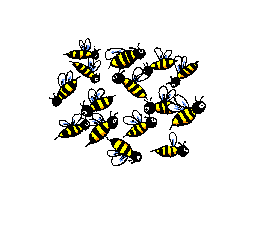According to Dr. Mike Merchant, Extension Entomologist for Texas A&M AgriLife Extension, Honey bees are fascinating social insects with a complex set of behaviors. One of the most interesting honey bee colony behaviors is known as “swarming.” Swarming is the method used by honey bees to start a new colony. A swarm is merely a honey bee colony in search of a nesting site. A swarm generally consists of a mated queen bee along with hundreds or thousands of accompanying worker bees. Swarming bees are not normally aggressive and can, in most cases, be approached safely. Unless you are an experienced beekeeper, however, it is best to avoid getting too close to swarming bees. Bees in swarms may, on occasion, sting intruders who venture too close. Although bee swarms generally pose little threat to people, and provide a unique chance to observe honey bee behavior, they can cause problems. When swarms come too close to areas of human activity, or frighten people with a fear of bees, they may need to be controlled. Also, in areas where Africanized honey bees are established, it may become necessary to control wild bee swarms.
Using soapy water to control bees: Soapy water is a safe and effective way to control undesired honey bee swarms. Soapy water applied in this manner is an effective tactic in “drowning’ honey bees only if they are clustered in an exposed swarm. It is less effective and is not recommended for controlling undesired, established colonies in areas like hollow trees, wall voids, or underground nests. Neither would it be recommended for killing managed colonies where bees are “on the comb”. Mix 3/4-1 cup of ordinary liquid dishwashing detergents in 1 gallon of water. Add the mixture to a regular hand-held, pump-up type garden sprayer. Wet the surface of the swarm with the soapy water and continue wetting as the outer layer of soaked bees fall from the swarm. Continue wetting the newly, exposed, dry bees until all have been thoroughly covered and drowned. You may want to place a garbage can or similar receptacle beneath the swarm to catch the soaked bees as they fall from the swarm (enhances “drowning” and simplifies removal). You may need to use the sprayer wand to hasten the “release” of “wetted” bees from the swarm surface and the exposure of the remaining, dry bees in the center of the swarm. Dawn liquid dishwashing detergent has been most extensively evaluated; however, other dishwashing detergents should be just as effective. Commercial insecticidal soaps do not seem to work as effectively as ordinary dishwashing detergents. Powdered (dry) dishwashing and laundry detergents have been used by APHIS/USDA in Mexico and South Texas with equally satisfactory results, however they have not been tested as thoroughly as the liquid detergents. Dry formulations are mixed at 3/4-1 cup per gallon of water, also. Warm water, though not necessary, helps the soap disperse quicker. Soapy water has been approved for use to control Africanized honey bees (AHB) by the Environmental Protection agency provided that: 1) the detergent used for AHB cannot be sold as a pesticide; and 2) the treatment mixture of detergent and water cannot be used on edible food and feed commodities. Bee swarms should not be killed indiscriminately. Bees are beneficial insects, helping pollinate flowers and vegetables. Unless a swarm is causing a distinct problem and cannot be tolerated, it should be left alone. Most honey bee swarms will leave a resting site within a few hours. Eliminating possible points of entry by bees into buildings and removing other potential nest sites is the best way to prevent serious problems with bees around structures.
Interested in learning more about bees and beekeeping? The Hopkins County Beekeepers meets every third Thursday at 6:30 PM at the Hopkins County Extension Office located at 1200 B Houston Street in Sulphur Springs. More info at facebook: Hopkins County Beekeepers.
For more information on this or any other agricultural topic please contact the Hopkins County Extension Office at 903-885-3443 or email me at [email protected].







